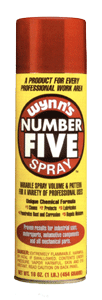PRODUCT IDENTIFICATION
| PRODUCT NAME | EFFECTIVE DATE | PRODUCT CODE |
| Wynn's No. Five Spray | 10-05-05 | 31002 |
| CHEMICAL NAME | | CAS NUMBER |
| N/A | | N/A |
HAZARDOUS INGREDIENTS
| COMMON NAME | CHEMICAL NAME | CAS NO. | OSHA PEL | ACGIH TLV-TWA |
| Petroleum Hydrocarbon |
Petroleum Oil |
64742-52-5 |
5 mg/m³ as mist |
5 mg/m³ as mist |
| Petroleum Hydrocarbon |
Distillates, Petroleum Hydrotreated, Light |
64742-47-8 |
None Established |
None Established |
| Petroleum Hydrocarbon |
Propane |
74-98-6 |
1000 |
2500 ppm |
Contains no other ingredients now known to be hazardous as defined by OSHA 29CFR 1910.1000(z) and 29CFR 1910.1200.
PHYSICAL DATA
These data are approximate or typical values and should not be used as precise specifications. Unless otherwise noted values are at 20°C(68°F) and 760 mmHg (1 atm).
| Boiling Point/Range |
-45 to 355°F (-43 to 194°C) |
Freeze Point |
N/D |
| Specific Gravity (H20=1) @ 15.6°C |
0.8-0.9 |
Vapor Pressure (mm Hg) |
50-60 |
| Vapor Density (Air =1) |
>1 |
Solubility in Water (%) |
Nil |
| % Volatiles by Volume |
≤50% |
Evaporation Rate (Butyl Acetate = 1) |
>1 |
| pH (as is) |
N/A |
pH (dilute) @ % |
N/A |
| Appearance |
Light Amber Clear Liquid |
Odor |
solvent |
N/D - Not Determined
< = Less Than
N/A - Not Applicable
> = Greater Than
FIRE AND EXPLOSION HAZARD DATA
Flash Point -156°F(-104°C) Method Tag Closed Cup
Hazard Class Identification
Flammability 4
Health 1
Reactivity 0
Other -
Hazard Code
0 - Least (insignificant)
1 - Slight
2 - Moderate
3 - High
4 - Extreme
Extinguishing Media
Dry chemicals, carbon dioxide, foam, water fog.
Special Fire Fighting Procedures
Use water to cool fire exposed containers. Fire fighters wear a self-contained breathing apparatus.
Unusual Fire and Explosion Hazards
Exposure to heat may cause bursting.
REACTIVITY DATA
Stability
Stable.
Conditions to Avoid
Heat, open flame.
Materials to Avoid
Strong oxidizing agents
Hazardous Decomposition or Combustion Products
Thermal decomposition may produce oxides of carbon, phosphorus and sulfur compounds.
Hazardous Polymerization (conditions) will not occur.
HEALTH HAZARDS/ROUTES OF ENTRY
Signs, Symptoms and Effects of Overexposure
Ingestion (swallowing) Ingestion of this material may cause vomiting. Aspiration into the lungs during ingestion
or vomiting can result in severe pulmonary damage.
Skin Contact May cause skin irritation upon direct contact. Prolonged contact may cause drying,
cracking, redness, & defatting of skin.
Eye Contact May cause moderate eye irritation.
Inhalation (breathing) May cause irritation to nose, throat and respiratory tract. May cause dizziness, headache.
Other Effects of Prolonged/Repeated Overexposure
This material has not been identified as a carcinogen by NTP, IARC or OSHA.
CHRONIC EFFECT: Repeated and prolonged overexposure to vapors may result in brain, nervous system,
kidney and liver damage.
EMERGENCY AND FIRST AID PROCEDURES
Ingestion (swallowing) DO NOT induce vomiting. Call physician immediately
Skin Contact Wash affected area with soap and water. Remove contaminated clothing.
Eye Contact Flush with water for 15 minutes. If irritation persists, call a physician.
Inhalation (breathing) Remove person to fresh air to avoid further inhalation.
SPILL OR RELEASE CONTROL PROCEDURES
Steps to be taken in case material is released or spilled
Remove all sources of ignition. Ventilate area. Avoid breathing of vapors. Remove with inert absorbent.
Waste Disposal Method
DO NOT incinerate. Dispose of in accordance with Federal, State and Local regulations.
EPA REPORTABLE QUANTITY (RQ), 40CFR302(CERCLA 104)
N/A
EPA Toxic Chemical Release Reporting, 40CFR372(SARA313)
| Chemical | CAS NO. | % in Product |
| N/A | N/A | N/A |
HANDLING AND STORAGE
Handling and Storage Precautions
Warning: Contains combustible petroleum distillates. Avoid skin contact and breathing of vapors. USE ONLY IN
A WELL VENTILATED AREA. Keep container closed. Keep away from flame, sparks or hot surfaces.
Other Precautions
KEEP OUT OF REACH OF CHILDREN.
PERSONAL PROTECTION - EXPOSURE CONTROL
Ventilation
General or local exhaust.
Respiratory Protection
Normal use, none required.
Eye Protection
Safety glasses.
Protective Gloves
Impervious gloves.
Other Protective Clothing or Equipment
None.
Work/Hygienic Practices
Personal cleanliness is always appropriate. Frequent washing minimizes chance of inadvertent exposure.
TRANSPORTATION INFORMATION
Department of Transportation (DOT) Classification
| | Flammable Liquid | | Corrosive |
| | Flammable Solid | | Non Flammable Gas |
| | Flammable Gas | | Non Hazardous by DOT |
| | Combustible Liquid | | Other |
DOT Proper Shipping Name
Aerosols
(Consumer commodity, ORM-D may be used for ground transportation within the USA.)
DOT ID Number
UN 1950
DOCUMENTATION
Product Code No.: 31002
Previous Code No.: 31002
Issue Date: 10-05-05
Prior Date: 03-04-05
This information is, to the best of our knowledge and belief, accurate and reliable as of the date compiled. However, no representation, warranty or guarantee is made as to its accuracy, reliability or completeness. It is the user's responsibility to satisfy himself as to the suitability and completeness of such information for his own particular use.
|



